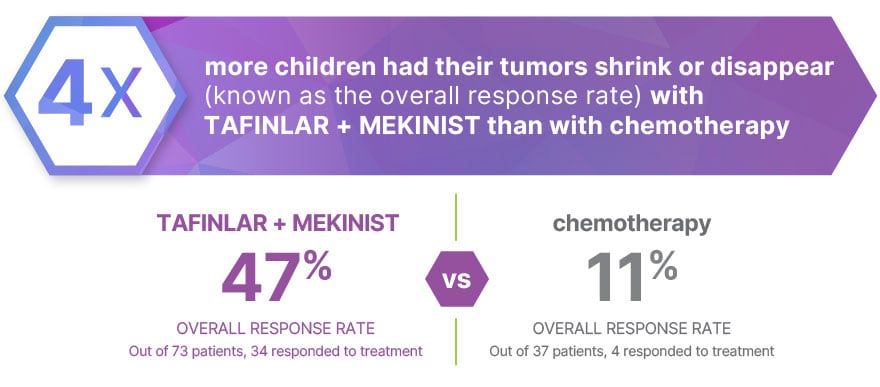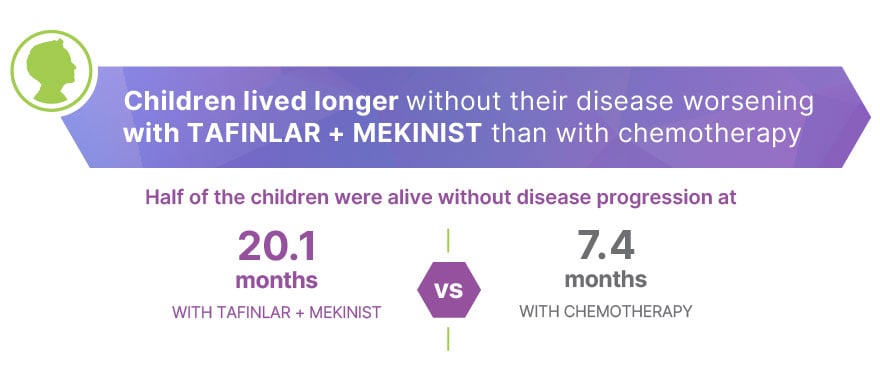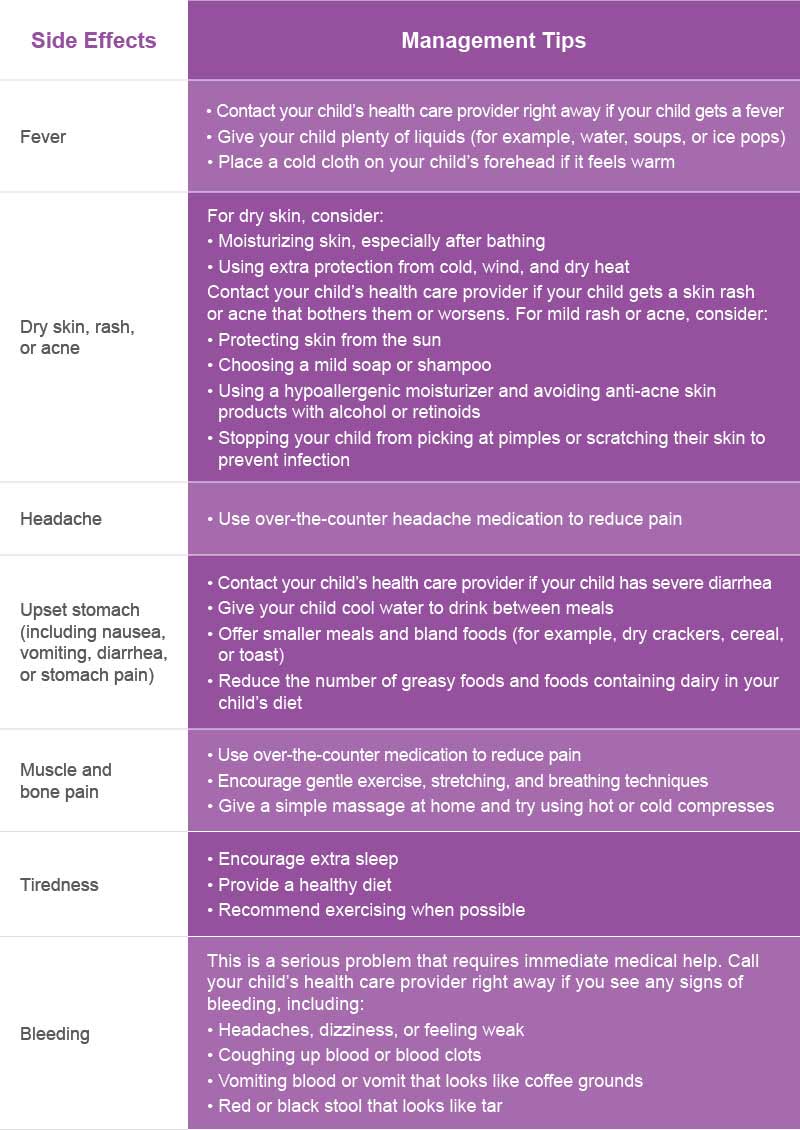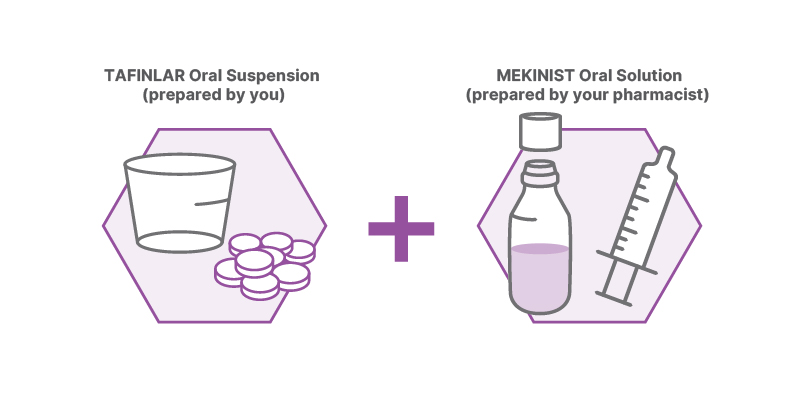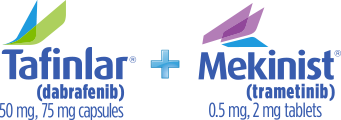APPROVED USE
TAFINLAR and MEKINIST are prescription medicines that can be used in combination to treat a type of brain tumor called glioma in children 1 year of age and older
- that is low-grade glioma (LGG), and
- that have a certain type of abnormal “BRAF” gene, and
- who require a medicine by mouth or injection (systemic therapy)
TAFINLAR, in combination with MEKINIST, is not for use in treating people with wild-type BRAF solid tumors.
Your health care provider will perform a test to make sure that TAFINLAR and MEKINIST in combination is right for you.
It is not known if TAFINLAR, in combination with MEKINIST, is safe and effective in children younger than 1 years of age. It is not known if TAFINLAR used alone is safe and effective in children.
IMPORTANT SAFETY INFORMATION
What is the most important information I should know about TAFINLAR in combination with MEKINIST? TAFINLAR and MEKINIST may cause serious side effects, including:
Risk of new skin cancers. TAFINLAR, when used in combination with MEKINIST, may cause a type of skin cancer called cutaneous squamous cell carcinoma, keratoacanthoma, basal cell carcinoma, or melanoma. Talk with your health care provider about your risk for these cancers.
Check your skin and tell your health care provider right away about any skin changes, including a new wart, skin sore, or reddish bump that bleeds or does not heal, or a change in size or color of a mole.
Your health care provider should check your skin before you start treatment, and every 2 months while on treatment, to look for any new skin cancers. Your health care provider should continue to check your skin for 6 months after you stop taking TAFINLAR and MEKINIST.
Your health care provider should also check for cancers that may not occur on the skin. Tell your health care provider about any new symptoms that have developed while taking TAFINLAR and MEKINIST in combination.
Bleeding problems. TAFINLAR and MEKINIST in combination can cause serious bleeding problems, especially in your brain or stomach, that can lead to death. Call your health care provider and get medical help right away if you have any signs of bleeding, including:
- headaches, dizziness, or feeling weak
- coughing up blood or blood clots
- vomiting blood or your vomit looks like “coffee grounds”
- red or black stools that look like tar
Inflammation of the intestines or tears (perforation) of the stomach or intestines. MEKINIST, alone or in combination with TAFINLAR, can cause inflammation of your intestines, or tears in the stomach or intestines that can lead to death. Tell your health care provider right away if you have any of the following symptoms:
- bleeding (see “Bleeding problems”)
- diarrhea (loose stools) or more bowel movements than usual
- stomach-area (abdomen) pain or tenderness
- fever
- nausea
Blood clots. TAFINLAR and MEKINIST in combination can cause blood clots in your arms or legs, which can travel to your lungs and lead to death. Get medical help right away if you have the following symptoms:
- chest pain
- sudden shortness of breath or trouble breathing
- pain in your legs with or without swelling
- swelling in your arms or legs
- a cool, pale arm or leg
Heart problems, including heart failure. Your health care provider should check your heart function before you start taking TAFINLAR and MEKINIST in combination, and during treatment. Call your health care provider right away if you have any of the following signs and symptoms of a heart problem:
- feeling like your heart is pounding or racing
- shortness of breath
- swelling of your ankles and feet
- feeling lightheaded
Eye problems. TAFINLAR and MEKINIST, in combination, can cause severe eye problems that can lead to blindness. Call your health care provider right away if you get these symptoms of eye problems:
- blurred vision, loss of vision, or other vision changes
- seeing color dots
- halo (seeing blurred outline around objects)
- eye pain, swelling, or redness
Lung or breathing problems. TAFINLAR and MEKINIST, in combination, can cause lung or breathing problems. Tell your health care provider if you have any new or worsening symptoms of lung or breathing problems, including:
- shortness of breath
- cough
Fever. Fever is common during treatment with TAFINLAR and MEKINIST, but it may also be serious. When taking TAFINLAR and MEKINIST, in combination, fever may happen often or may be severe. In some cases, chills or shaking chills, too much fluid loss (dehydration), low blood pressure, dizziness, or kidney problems may happen with the fever. Call your health care provider right away if you get a fever while taking TAFINLAR or MEKINIST.
Your health care provider may temporarily or permanently stop your treatment or change your dose of MEKINIST with TAFINLAR if you have fevers. Your health care provider will treat you as needed for your fever and any signs and symptoms of infection and should check your kidney function during and after you have had severe fever.
Serious skin reactions. Skin rash is a common side effect of TAFINLAR and MEKINIST. In some cases, these rashes and other skin reactions can be severe or serious, may need to be treated in a hospital, or lead to death.
- tell your health care provider if you get a skin rash or acne that bothers you or worsens
- tell your health care provider right away if you develop any of the following signs or symptoms of a severe skin reaction, including:
- blisters or peeling of your skin
- mouth sores
- high fever or flu-like symptoms
- blisters on your lips, or around your mouth or eyes
- enlarged lymph nodes
Increased blood sugar (hyperglycemia). Some people may develop high blood sugar or worsening diabetes during treatment with TAFINLAR and MEKINIST in combination. If you are diabetic, your health care provider should check your blood sugar levels closely during treatment with TAFINLAR and MEKINIST. Your diabetes medicine may need to be changed. Tell your health care provider if you have any of the following symptoms of severe high blood sugar:
- increased thirst
- urinating more often than normal, or urinating an increased amount of urine
TAFINLAR may cause healthy red blood cells to break down too early in people with glucose-6-phosphate dehydrogenase (G6PD) deficiency. This may lead to a type of anemia called hemolytic anemia, where the body does not have enough healthy red blood cells. Tell your health care provider if you have any of the following signs or symptoms:
- yellow skin (jaundice)
- weakness or dizziness
- shortness of breath
Hemophagocytic Lymphohistiocytosis (HLH). TAFINLAR when taken with MEKINIST may increase the risk of a type of overactivity of the immune system (hemophagocytic lymphohistiocytosis) that can cause fever, swollen glands, bruising, or skin rash. If you experience a combination of these symptoms, call your health care provider right away.
TAFINLAR and MEKINIST, in combination, can harm your unborn baby.
Your health care provider will do a test to see if you are pregnant before starting treatment with TAFINLAR and MEKINIST in combination.
Women who are able to become pregnant should use effective birth control (contraception) during treatment with TAFINLAR and MEKINIST in combination, and for 4 months after stopping treatment with TAFINLAR and MEKINIST.
Birth control using hormones (such as birth control pills, injections, or transdermal systems) may not work as well while you are taking TAFINLAR and MEKINIST in combination. You should use another effective method of birth control while taking TAFINLAR and MEKINIST in combination.
Talk to your health care provider about birth control methods that may be right for you during this time.
Tell your health care provider right away if you become pregnant, or think you might be pregnant, during treatment with TAFINLAR and MEKINIST in combination.
Men (including those who have had a vasectomy) with a female partner who is able to become pregnant should use condoms during sexual intercourse during treatment with TAFINLAR and MEKINIST for at least 4 months after your last dose of TAFINLAR and MEKINIST in combination.
The most common side effects of TAFINLAR when taken with MEKINIST in children 1 year of age and older with low-grade glioma include:
- fever
- rash
- headache
- vomiting
- muscle and bone pain
- tiredness
- dry skin
- diarrhea
- nausea
- bleeding
- stomach-area (abdomen) pain
- acne
New or worsening high blood pressure (hypertension). Your health care provider should check your blood pressure during treatment with MEKINIST. Call your health care provider right away if you develop high blood pressure, your blood pressure worsens, or you have severe headache, lightheadedness, blurry vision, or dizziness.
Fertility problems. TAFINLAR and MEKINIST, in combination, may cause fertility problems in women. This could affect the ability to become pregnant. Talk to your health care provider if this is a concern for you.
Low sperm counts. TAFINLAR may cause lower sperm counts in men. This could affect the ability to father a child. Talk to your health care provider if this is a concern for you.
Nursing mothers. It is not known if TAFINLAR and/or MEKINIST pass into breast milk. Do not breastfeed during treatment, and for 4 months after your last dose of TAFINLAR and MEKINIST. Talk to your health care provider about the best way to feed your baby during this time.
These are not all the possible side effects of TAFINLAR and MEKINIST. For more information about side effects, ask your health care provider or pharmacist.
Before you take TAFINLAR and MEKINIST in combination, tell your health care provider about all your medical conditions, including if you:
- have had bleeding problems or blood clots
- have stomach problems
- have inflammation of the colon
- have heart problems
- have eye problems
- have lung or breathing problems
- have high blood pressure (hypertension)
- have liver or kidney problems
- have diabetes
- plan to have surgery, dental, or other medical procedures
- have a deficiency of the G6PD enzyme
- are pregnant or plan to become pregnant
- are breastfeeding or plan to breastfeed
Tell your health care provider about all the medicines you take, including prescription and over-the-counter medicines, vitamins, and herbal supplements. Know the medicines you take. Keep a list of them to show your health care provider and pharmacist when you get a new medicine.
Please read the Medication Guide for TAFINLAR and the Patient Information for MEKINIST and discuss any questions you have with your health care provider.
You are encouraged to report negative side effects of prescription drugs to the FDA. Visit www.fda.gov/medwatch, or call 1-800-FDA-1088.
Please see full Prescribing Information for TAFINLAR, including Medication Guide, and full Prescribing Information for MEKINIST, including Patient Information.

